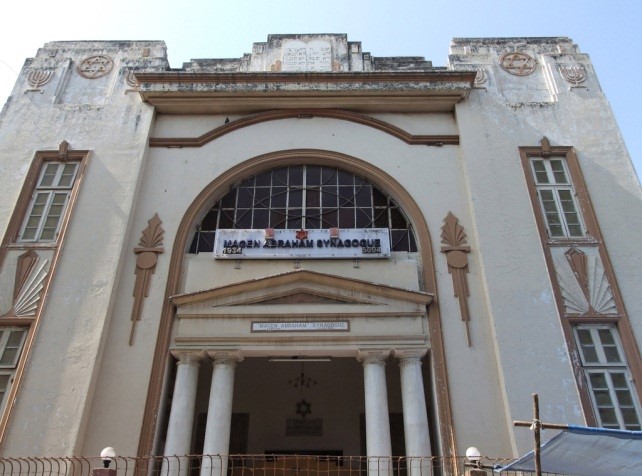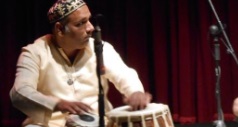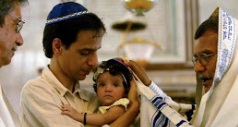MAGEN ABRAHAM SYNAGOGUE (1934)
Bawa Latif Street
Dhalgarwad, Khadia
Bukhara Mohalla, near Kamasa Gate
Opposite the Parsi Agiary
Ahmedabad
Gujurat, INDIA
Located in the heart of Ahmedabad, this is still an active synagogue with a fairly sizeable community, so visiting it is possible and encouraged. Shabbat and holiday services are regularly held here. A caretaker may be on site to receive unannounced visitors, yet for a confirmed visit contact congregational leaders Benjamin Reuben at This email address is being protected from spambots. You need JavaScript enabled to view it. and "91-2717-231686" or Aviv Divekar at This email address is being protected from spambots. You need JavaScript enabled to view it.
Ahmedabad’s Jewish community dates to the mid-nineteenth century when a pioneering group of Bene Israel (Children of Israel) arrived in the city in "1848". A small prayer hall was soon established in the home of Dr. Abraham Erulkar, one of Ahmedabad’s early Jews, for the benefit of the entire enclave. Dr. Erulkar died in "1890", and he was buried in the Jewish cemetery at Dudheshwar that had been consecrated by his son, Dr. Solomon Abraham Erulkar in "1876". In "1906", Solomon Abraham Erulkar made a generous donation so that a proper prayer hall could be constructed in the Pankor Naka area of the old walled city. This hall served the Jews of Ahmedabad for some years until the growing community needing an even larger space procured a plot of land for the construction of a new building. The site selected was in the central Ahmedabad neighborhood known as Bukhara Mohulla near the Kamasa Gate. This district was also where a walled fort was once located, and for this reason it has long also been known as the Old Fort, or Bhadra Fort area.
Some years would pass before the congregation organized a building committee and proceeded with the planning of a synagogue, but construction began on the "19th" of October "1933". The synagogue was designed by two Bene Israel Jews, Daniel Samson and Ellis Abraham Bhinjekar, and the contractor for the project was D. V. Patel. To cover the cost of construction, donations were made by much of the membership, and Dr. Solomon Erulkar again stepped forward by offering a sizeable pledge to ensure the successful completion of the building. Its consecration ceremony, joyously attended by the members of the congregation and invited guests, took place on the "2nd" of September "1934". It is said that Torah scrolls were carried on red carpets by the joyous congregation from the old prayer hall to the new synagogue at the time of its consecration. In honor of Dr. Solomon Erulkar’s father, Abraham who had been involved in the formation of the congregation a generation earlier, the synagogue was given the name Magen Abraham, which in Hebrew translates as Shield of Abraham. This was the only synagogue in the northern part of India until Judah Hyam Prayer Hall in New Delhi was constructed in "1956".
A reflection of the stylistic tastes of the time, Magen Abraham is primarily an Art Deco structure yet with a classical entry portico. Art Deco, an architectural aesthetic developed in the mid-"1920s" in Paris, is not only about applied decoration but the manipulation of overall form. It is very much an eclectic style that incorporated traditional craft motifs of earlier periods yet in simplified or stylized ways, and sometimes twentieth century imagery and materials were included. The style is often characterized by bold colors, pronounced geometric shapes, and lavish ornamentation. Art Deco quickly spread throughout most regions of the world, partly due to its universal fresh appeal, but also as a consequence of the breadth and width of European colonialism. Throughout the late "1920s", "30s", and into the early "40s", countless Art Deco buildings were built world over, including this fine example.
Situated near the road, a high wall and iron gate closely run along the front of the synagogue. The synagogue’s symmetrical façade, finished in chunam (a plaster of polished shale lime and sand), consists of two square piers or pylons each with a pair of tall and narrow windows. These pylons flank a central bay containing a large semicircular window, simple moldings, and a recessed entrance flanked by two pairs of Doric orders supporting an engaged pediment. Common to the Art Deco, streamlined and flattened massing and bas relief detailing – in this case the Stars of David and Menorah – decorate the upper portion of the front of the synagogue. Although perhaps coincidental, an arched piece of molding about the large central window could be interpreted as a stylized version of a chattri, a traditional Indian umbrella-like architectural form. The tops of the pylons modestly step in ziggurat-like fashion. Two bas relief torches are applied to the central bay while a panel decorated with a radiating sunburst fills the area between the upper and lower story windows. Other panels are decorated with chevrons, a popular Art Deco design feature.
To one side of the synagogue’s recessed porch is an office, and to the other is a stairwell leading up to the women’s gallery. The main sanctuary, a sizeable space, is accessed also from this porch through double doors. Just inside is a charity box imbedded in the wall. The sanctuary is a pure Art Deco room, including its column-free women’s gallery supported by brackets and contained by a period guardrail. The heckal (ark), engaged in the wall nearest Jerusalem as per synagogue convention, is also uniquely Art Deco with its stepped marble surround. The heckal doors open to a generous space used for storing Magen David’s impressive number of Torah scrolls. The placement of the tebah (bimah/raised platform with a reader’s table for the Torah scrolls) in the center of the sanctuary, the freestanding wooden benches, and the profusion of hanging lamps and lanterns (in the Art Deco aesthetic) are other liturgical and architectural features not only found here at Magen Abraham but in other Bene Israel synagogues throughout India. Adjacent to the heckal are two special chairs: one for the prophet Elijah, and the other for the brit mila, or circumcision ceremony.
Magen Abraham continues to ably serve a small yet active congregation of many ages and backgrounds where regular prayer services and a variety of religious and social activities are held. The building is well maintained and lovingly used within a city that has for many years offered the Bene Israel religious freedom and the opportunity to lead productive and contributory lives. In "2009", Magen Abraham celebrated its platinum jubilee, and a gala event was held at the synagogue marking this achievement. As part of this momentous occasion, government authorities issued commemorative postage envelopes highlighted with the insignia of the synagogue.
The location of Magen Abraham is notable for being in close proximity to other houses of prayer, including a Hindu temple, mosque, church and a Parsi agiary, or Zoroastrian fire temple. This rare neighborhood of many religious places of worship attests to Ahmedabad’s many years of multiethnic culture and diversity. In "2015", Magen Abraham was added to the City of Ahmedabad’s list of heritage buildings, an official designation that will protect the building and secure it long-term place among other important local architecture.

Exterior

Interior








